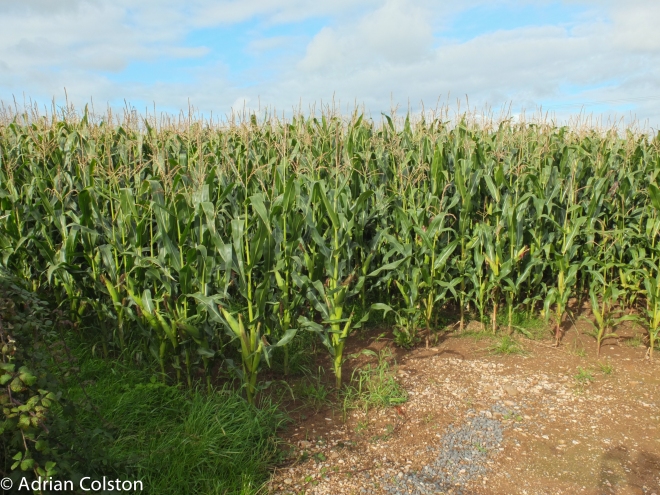It rained pretty heavily Friday night and Saturday morning and as a result the little stream near my garden in Exton was in spate. It often does and unfortunately Station Road by the Church sometimes floods.
The little stream on this occasion stayed within its banks but what was startling was the colour of the water – it was deep brown. The stream doesn’t have a large catchment so I decided to have a look around Exton and Woodbury to see if I could work out why the river was so coloured.

The little stream up past Woodbury was also running brown

It soon became clear what the problem was – quite a lot of the catchment is growing maize which isn’t harvested until late autumn. Harvesting maize also requires a lot of tractor work which compacts the soils and causes wheel ruts to form. The fields at this time of year are devoid of any vegetation.

Here is the same field in September resplendent with its crop of maize. Maize is used as a fodder crop for cattle or can be used in an anaerobic digester to produce energy. I don’t know the fate of the maize around Exton and Woodbury though.
 The problems are exacerbated when the crops are on sloping fields. They quickly become waterlogged during heavy rain which then runs off the land taking a suspension of soil with it. The rain is literally washing the field’s soil into the stream. In addition – as the fields are compacted and waterlogged the speed that the water runs off at is accelerated which leads to quicker flash flooding.
The problems are exacerbated when the crops are on sloping fields. They quickly become waterlogged during heavy rain which then runs off the land taking a suspension of soil with it. The rain is literally washing the field’s soil into the stream. In addition – as the fields are compacted and waterlogged the speed that the water runs off at is accelerated which leads to quicker flash flooding.

Elsewhere in the catchment are autumn sown cereal crops – again the fields are largely bare and again the rain can wash the soil away. Maize fields are however particularly susceptible to this phenomenon.

The catchment also possesses permanent pastures which are much better at holding back the rain from the river
As a result of all of this I have done a little research into the growing of maize in Britain. Apparently over the last decade there has been an enormous growth in the growing of maize and now over 160,000 ha. are grown in southern Britain with a significant proportion in Devon. This growth has been pretty controversial too. Interesting I found a 2014 report from the Soil Association on the problems – it is worth a read click here for their report ‘Runaway Maize’.
It doesn’t seem to me to be a very sustainable farming practice if it leads to such soil degradation. It is also the height of irony that on one hand the Environment Agency are working to stop communities from flooding whilst their parent Department of Governement DEFRA are promoting and supporting via the Common Agricultural Policy and the Renewable Heat Incentive the growth of maize.

Hi Adrian
There are organisations, such as The Game & Wildlife Conservation Trust’s “Allerton Project” in Loddington, Leicestershire, that are looking into these sorts of problems. One solution where there is run-off like this, is to dig a pond at a low point and allow it to ‘silt-up’ with the run off over a period of time, until it can be dredged and the soil – and any nutrients – returned to their place on the fields. The added bonus is that the pond provides a habitat for amphibians, insects etc in the meantime. They also advocate ‘beetle banks’, planting seed for wild birds on areas of fields that are known not to grow crops particularly well, planting hedges and lines of trees, etc etc. All good stuff.
Love the blog, by the way!
Karen Slatcher
hi there,quite narrow bands of grass /geotex are very effective at reducing soil erosion of this sort which is good for the farmer,the environment and the long term viability of the land.
Click to access 5421_CRA01_Grassed_Waterway_FINAL.pdf
maybe tell them about it
Click to access 5421_CRA01_Grassed_Waterway_FINAL.pdf
sorry if that is a double comment ,it works well and is good for the farmer and the environment
Pingback: More flooding in Lancashire, Yorkshire and North Wales from a Storm with no name | A Dartmoor blog
Pingback: Taming the Floods | A Dartmoor blog
Pingback: Storm Frank comes close to home | A Dartmoor blog